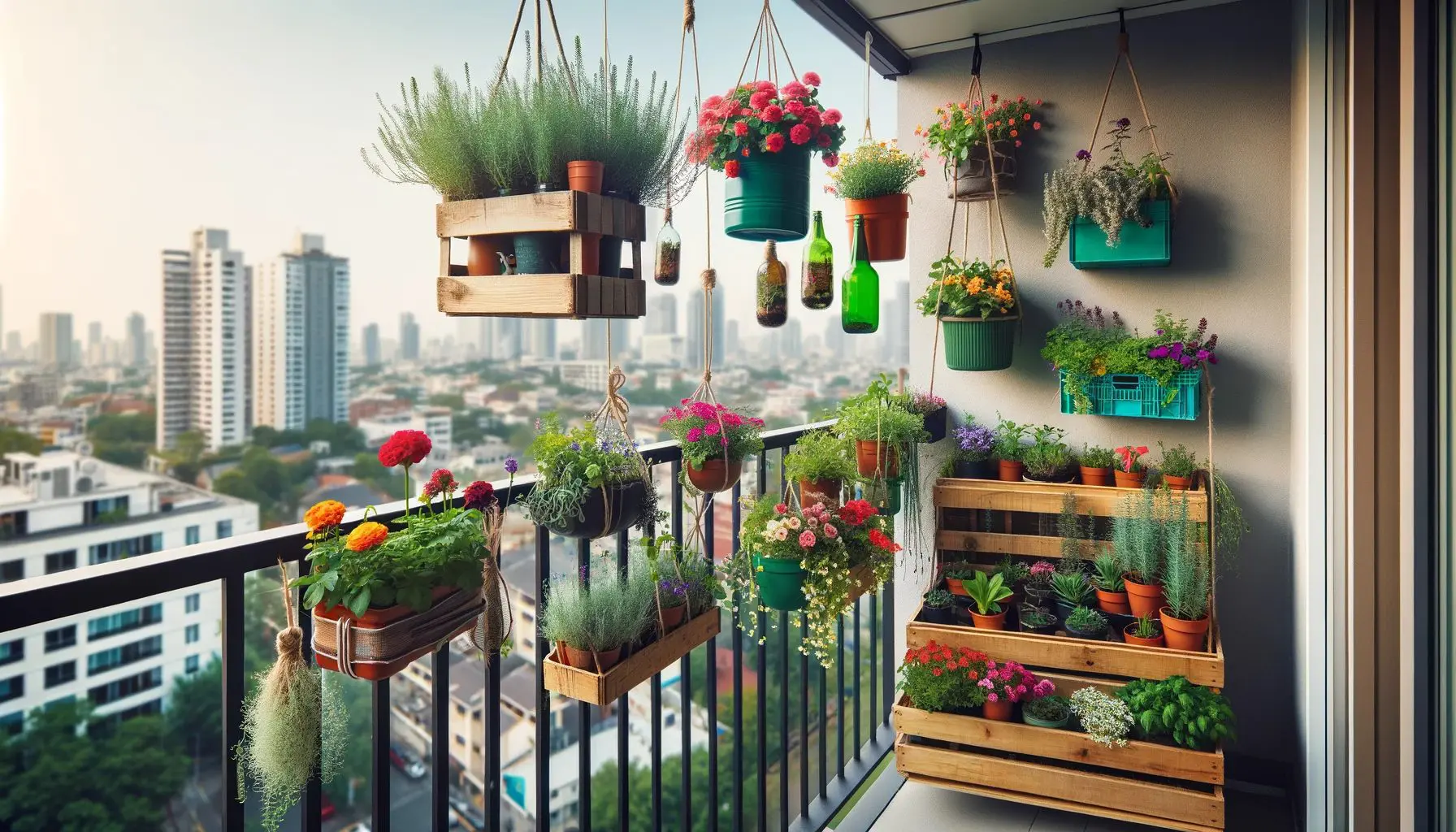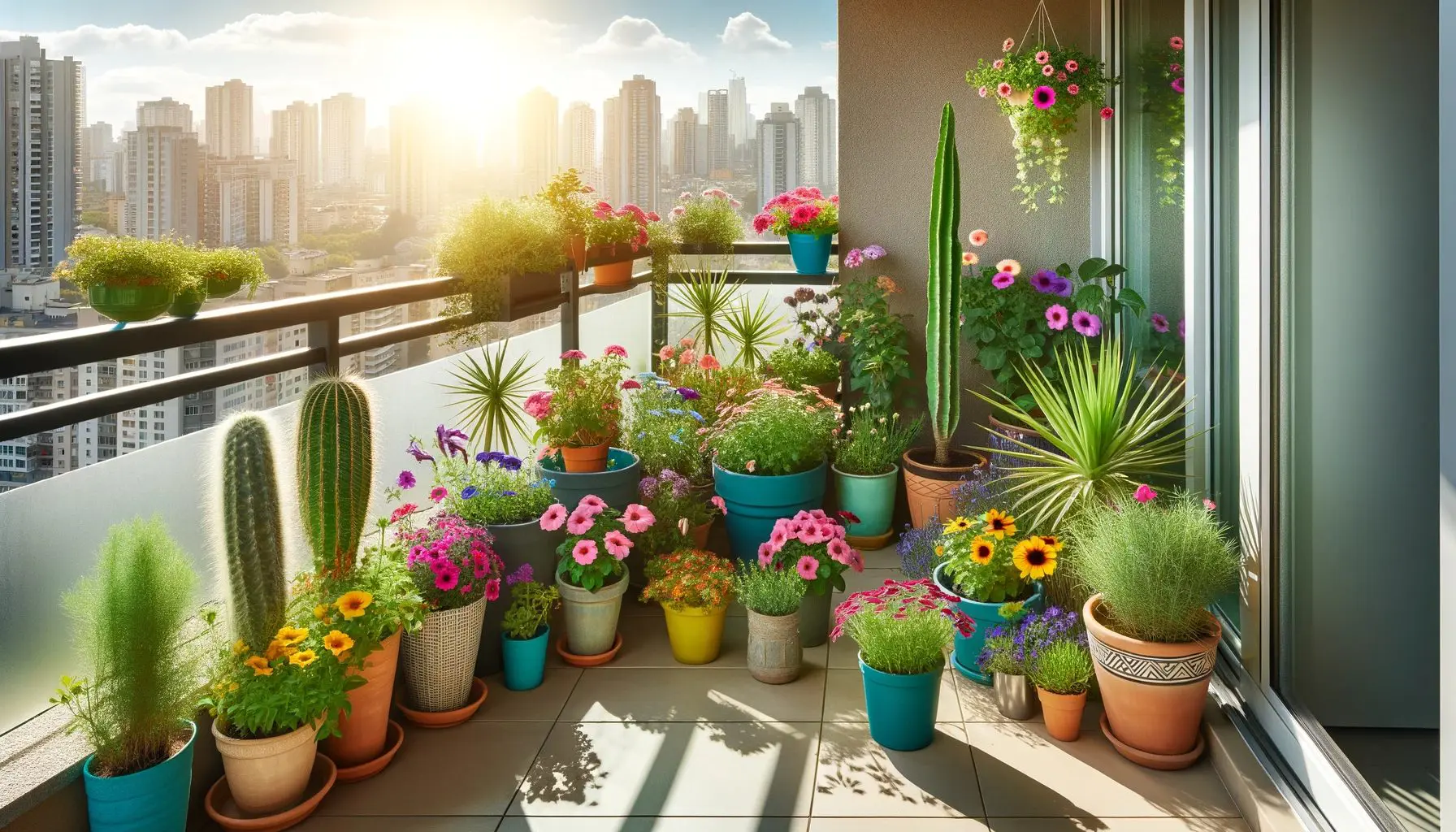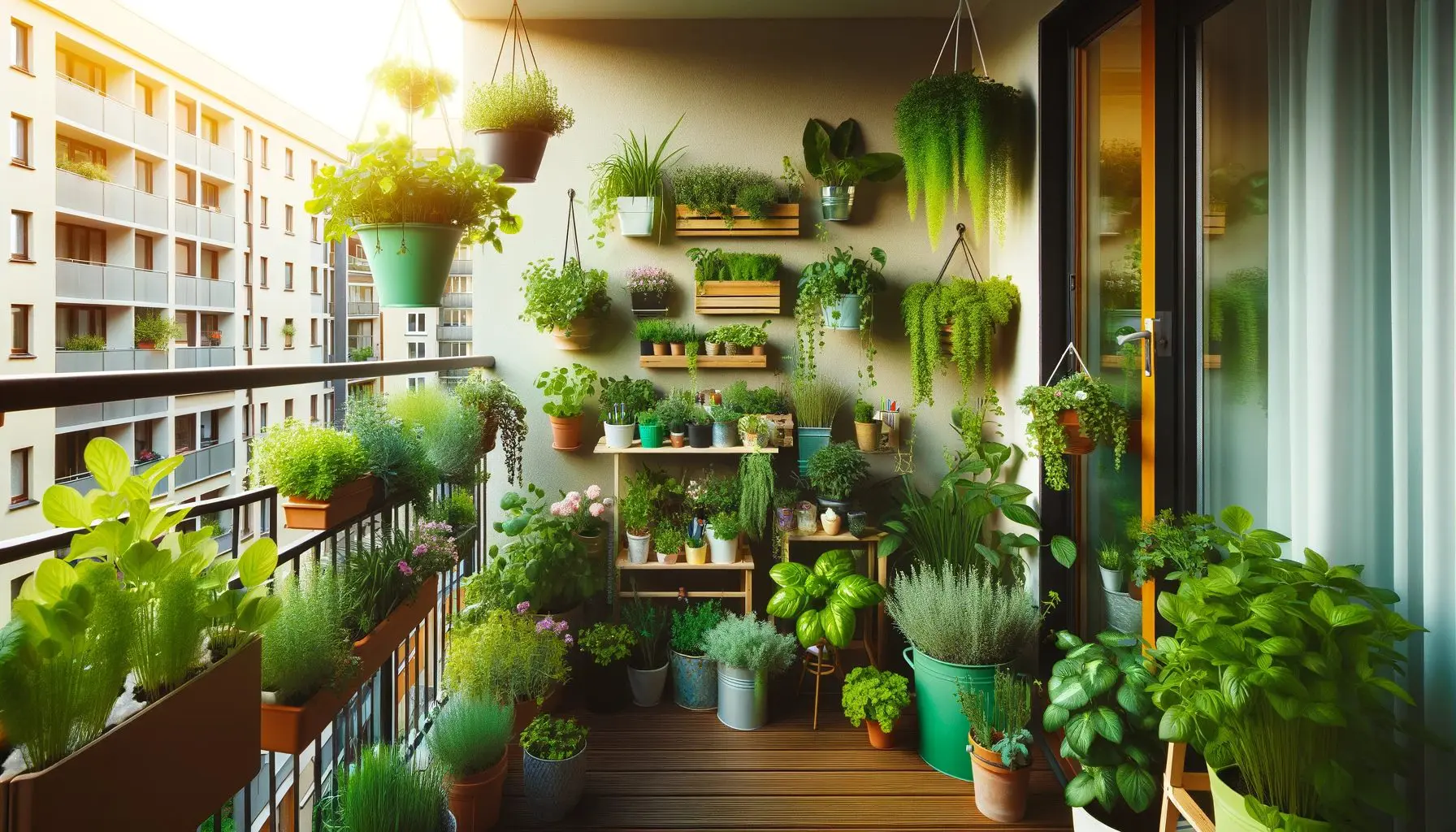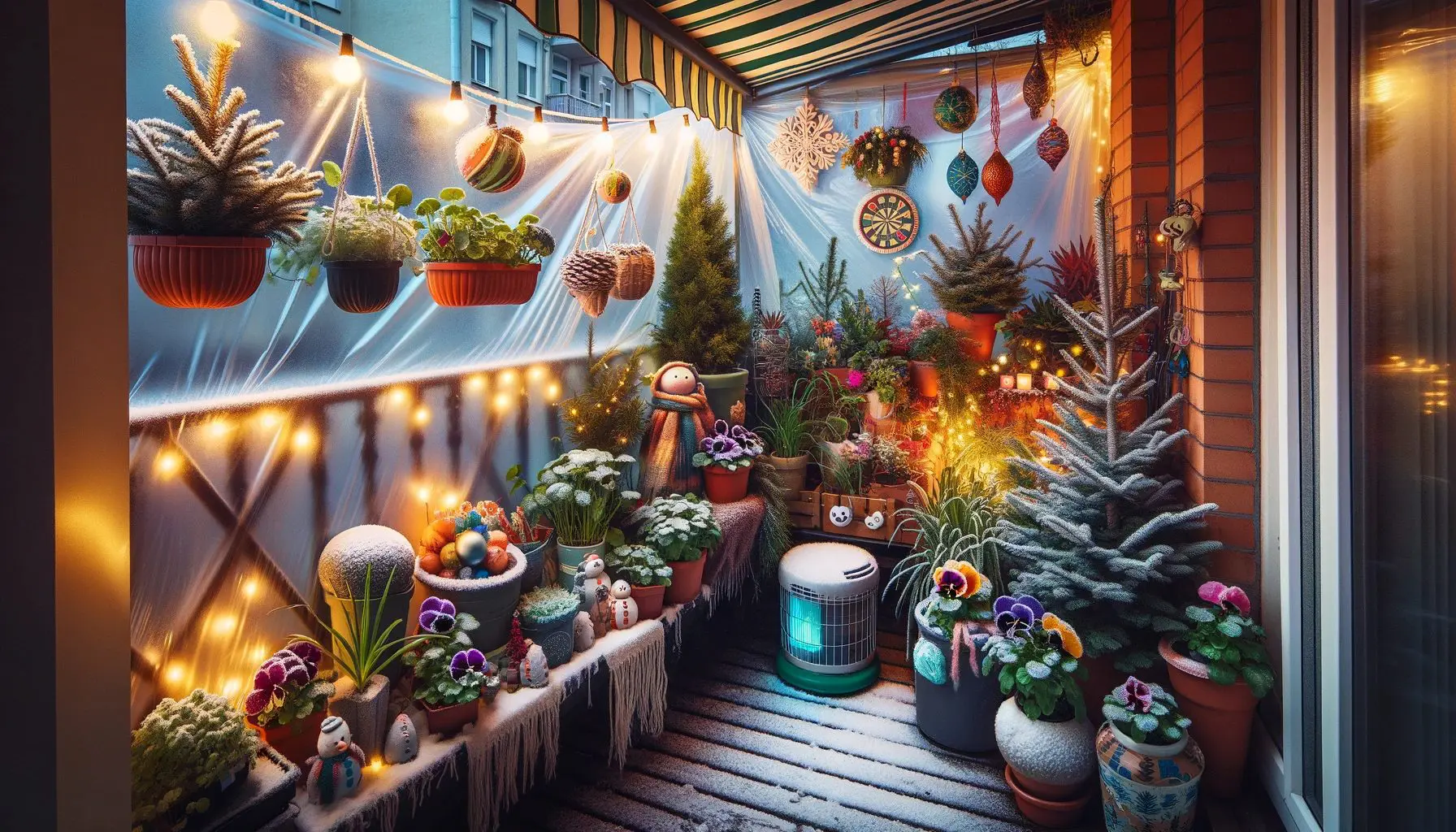This post contains affiliate links. If you buy something from one of our links we may earn a commission. Thanks
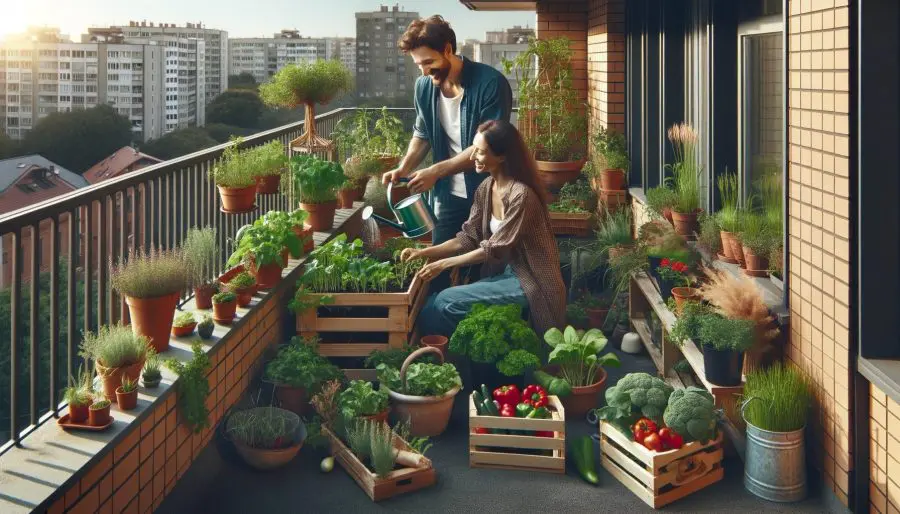
Discover the joy of balcony vegetable gardening! Our tips and tricks make it easy to start your own lush, green oasis in the city. Dive in now!
Balcony Vegetable Garden Key Takeaways:
- Growing an apartment balcony vegetable garden is a rewarding way to utilize small spaces.
- Start with pots or planters, choose sun-loving veggies like tomatoes and herbs, and ensure regular watering.
- With the right care, even a small balcony can yield a plentiful, fresh harvest.
Ready to spruce up your urban space with some balcony vegetable garden ideas?
Whether you’ve got a green thumb or you’re a total newbie, we’ve got all the fun, practical tips you need to turn that balcony into a flourishing vegetable haven. Let’s get growing!
Balcony Vegetable Gardening: A Fresh Approach to Urban Living
In the heart of bustling cities, balcony vegetable gardening emerges as a beacon of sustainability and personal fulfillment.
This guide unveils the secrets to transforming your urban balcony into a verdant haven of fresh vegetables, herbs, and flowers.
Balcony gardening not only brings the joy of growing your own food to small spaces but also serves as a delightful escape from the concrete jungle, offering a patch of nature right outside your door.
Whether you’re a seasoned green thumb or a budding gardener, this journey into urban horticulture promises to enrich your lifestyle, one plant at a time.
Balcony vegetable gardening transforms small urban spaces into green, productive havens.
Imagine stepping onto your balcony to pluck fresh tomatoes, crispy lettuce, and fragrant herbs.
This isn’t just a dream for rural dwellers; it’s a reality for city residents seeking sustainability and healthful living.
Balcony Vegetable Garden Key Takeaways
- Transform your balcony into a productive vegetable garden.
- Understand key considerations like space, light, and regulations.
- Discover the best vegetables suitable for balcony gardening.
- Learn essential gardening tips for a flourishing balcony garden.
Reaping the Rewards of a Balcony Vegetable Garden
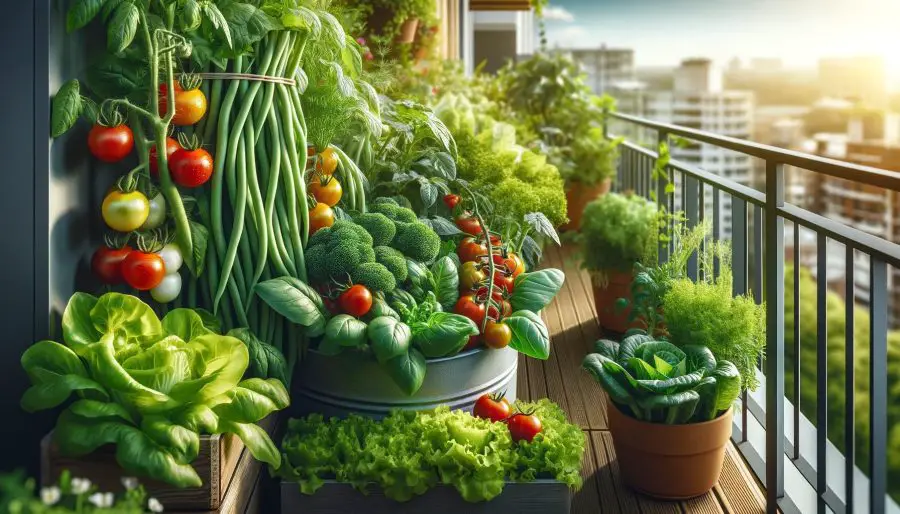
Balcony vegetable gardening offers more than just an enhancement to your living space’s aesthetics; it’s a transformative approach to your lifestyle and diet.
This practice serves as a gateway to healthier eating habits, enabling you to grow and consume fresh, organic produce right at your doorstep.
By cultivating your own vegetables, you significantly reduce your dependence on commercially farmed produce, which often involves long-distance transportation and potential exposure to pesticides and preservatives.
Moreover, a balcony garden can lead to considerable savings on grocery bills.
By growing staple vegetables like tomatoes, lettuce, and herbs, you can have a continual supply of fresh ingredients for your meals, eliminating the need for frequent trips to the store.
This not only saves money but also reduces your carbon footprint by cutting down on the transportation emissions associated with grocery shopping.
Additionally, there’s a profound sense of satisfaction and empowerment that comes from growing your own food.
It encourages a deeper connection with nature and the food you eat.
You gain control over what goes into your food, ensuring that your vegetables are grown without harmful chemicals.
This not only benefits your health but also contributes to a more sustainable and environmentally friendly approach to living.
In summary, balcony vegetable gardening is a rewarding endeavor that benefits your health, wallet, and the environment.
It’s a small yet impactful step towards a more sustainable and self-sufficient lifestyle.
Planning for Success: Key Considerations Before You Begin
Before you start, assess your balcony’s suitability. How much sun does it get? Is there adequate protection from harsh weather?
Understanding these factors is crucial for a thriving garden. Also, consider the weight capacity of your balcony.
Heavy pots and soil can add up, so ensure your space can safely support your garden.
Assessing Balcony Suitability and Climate
Sunlight Exposure: Evaluate how much direct sunlight your balcony receives daily.
Different vegetables have varying sunlight needs, so understanding your balcony’s exposure helps in selecting suitable plants.
Weather Protection: Consider the typical weather patterns in your area. Is your balcony exposed to strong winds or heavy rain?
Strategies for protecting your garden from extreme weather conditions are essential.
Understanding Balcony Capacity and Safety
Weight Considerations: It’s vital to know the weight capacity of your balcony.
Calculate the combined weight of pots, soil, water, and plants to ensure it’s within safe limits.
Structural Safety: Regularly inspect your balcony for any signs of wear or damage.
Safety should be a priority, especially when adding significant weight with garden containers and equipment.
Optimizing Space and Layout
Space Planning: Maximize your balcony’s potential by strategically planning the layout.
Consider the size and shape of containers and how they can be arranged efficiently.
Vertical Gardening Solutions: Utilize vertical space through wall-mounted planters or hanging pots to grow more in less space.
This approach not only saves floor space but also adds an aesthetic dimension to your garden.
Choosing the Right Crops for Your Balcony
Not all vegetables are suited for balcony life. Some, like tomatoes and beans, thrive in pots and require minimal space.
Others, like root vegetables, need deeper soil. We’ll explore a variety of vegetables perfect for your balcony, from leafy greens to flavorful herbs.
Selecting the Right Vegetables:
Tomatoes and Beans: Perfect for Pots
- Tomatoes and beans are ideal for balconies due to their adaptability to container life.
- Compact varieties like cherry tomatoes and bush beans thrive in pots, making them perfect for small spaces.
- These plants can be easily managed and supported with stakes or cages, ensuring a bountiful harvest.
Leafy Greens:
- A Balcony Favorite Leafy greens such as lettuce, spinach, and kale are excellent for balcony gardens.
- Their shallow root systems make them well-suited for shallow containers.
- Quick to grow and harvest, they offer continuous production, providing fresh greens for your kitchen in a short period.
Herbs: Small but Mighty:
- Herbs like basil, mint, and parsley are perfect for small spaces due to their compact size.
- These aromatic plants add fresh flavors to meals and can be grown in small pots or even window boxes.
- They require minimal space and care, making them a practical addition to any balcony garden.
Root Vegetables: Deeper Pots for Deeper Roots:
- Growing root vegetables like carrots and radishes in balconies is possible with deeper containers. These vegetables require more soil depth for root development.
- Choose pots at least 12 inches deep and provide consistent moisture. With proper care, they can flourish, offering fresh, homegrown produce.
Balcony Gardening Tips for Each Vegetable Type:
Ideal Soil and Fertilization:
For healthy balcony vegetable growth, use a high-quality potting mix rich in organic matter.
Different vegetables have specific nutrient needs; adding compost or a balanced, slow-release fertilizer can meet these requirements.
Regularly check and adjust soil pH to suit the specific needs of each vegetable type.
Sunlight Needs and Positioning:
Vegetables typically need 6-8 hours of sunlight daily. Position pots in areas of your balcony that receive consistent sunlight.
Use a movable platform or rotate pots for even exposure. Leafy greens tolerate some shade while fruiting vegetables like tomatoes and peppers require more direct sunlight.
Watering Strategies:
Watering needs vary among vegetables. Most require consistent moisture, especially during growth and fruiting stages.
Use a watering can or drip irrigation for even distribution. Check soil moisture before watering; it should be moist, not waterlogged.
Mulching can help retain moisture and reduce watering frequency.
Maximizing Space with Vertical Gardening:
Vertical gardening optimizes limited balcony space. Use trellises, hanging baskets, and wall-mounted planters for climbing vegetables like beans and vining tomatoes.
This approach not only saves floor space but also adds a vertical element to your garden, making it more productive and visually appealing.
Overcoming Challenges in Balcony Vegetable Gardening:
Managing Limited Space:
To optimize space on a small balcony, select compact vegetable varieties like dwarf tomatoes and bush beans. Utilize vertical space with hanging planters and wall-mounted pots.
Consider multi-tiered plant stands to grow more in the same footprint. These strategies allow for a diverse range of vegetables without overcrowding your balcony.
Adapting to Your Balcony’s Microclimate:
Adapt your balcony garden to its unique microclimate. For sunny balconies, focus on sun-loving plants like peppers and eggplants.
In windy conditions, use windbreaks or choose hardier plants. For shaded balconies, grow vegetables that thrive in lower light, such as leafy greens and some herbs.
Tips and Tricks for a Lush Balcony Garden
Learn how to maximize your limited space. Discover the benefits of vertical gardening, the importance of choosing the right soil, and how to water your plants efficiently. We’ll also cover pest control and how to keep your garden healthy and vibrant.
Maximizing Space in a Balcony Garden:
Utilize every inch of your balcony effectively. Choose compact plant varieties and arrange them in tiered planters or shelves to create more growing space.
Consider growing upwards using trellises for climbing plants like cucumbers and peas. This approach not only saves floor space but also adds a vertical aesthetic element to your garden.
The Benefits of Vertical Gardening:
Vertical gardening is not just a space-saver; it’s a creative way to enhance the beauty of your balcony.
Use wall planters, hanging baskets, and trellises for a variety of plants.
This method allows for better air circulation and sunlight exposure, which are crucial for healthy plant growth.
It also makes tending to your garden easier, as plants are more accessible.
Choosing the Right Soil and Fertilization:
Selecting the appropriate soil is critical for balcony gardening. Opt for high-quality potting mixes that provide good drainage and aeration.
Coco coir is an ecological and sustainable alternative to peat-based soil mixes it provides excellent water retention and soil aeration and it is pH neutral. However, it lacks nutrients so must be fertilized.
Regularly add organic compost or a balanced, slow-release fertilizer to replenish nutrients.
Tailor your soil and fertilization strategy to each plant’s needs, ensuring they get the right nutrients for optimal growth.
Efficient Watering and Pest Control Strategies:
Efficient watering is key. Water your plants early in the morning or late in the evening to minimize evaporation. Use a watering can with a long spout for precision.
For pest control, regularly inspect plants for signs of infestation. Use natural remedies like neem oil or insecticidal soap to tackle pests without harming beneficial insects.
Healthy, well-cared-for plants are less likely to succumb to diseases and pests.
Creative Ways to Elevate Your Balcony Garden
Innovative solutions like vertical gardening are not just space-savers but also eye-catching additions.
Use trellises for climbing plants like beans and cucumbers. Consider using hanging baskets for herbs and cherry tomatoes.
This approach not only maximizes space but also adds a unique aesthetic to your balcony.
-
Innovative Vertical Gardening Techniques:
- Trellises and Climbing Plants: Utilize trellises for climbing vegetables like beans, peas, and vining tomatoes. Trellises can be decorative and functional, allowing plants to grow upwards, which not only saves space but also creates a natural green backdrop.

- Hanging Gardens: Implement hanging baskets for growing herbs like basil and mint, or small fruits like strawberries. These baskets can be suspended from the ceiling or balcony railing, offering a unique vertical dimension.
- Wall Planters: Install wall planters to grow a variety of herbs, greens, and flowering plants. This approach can turn a bare wall into a lush, living tapestry, adding beauty and freshness to your balcony space.

- Trellises and Climbing Plants: Utilize trellises for climbing vegetables like beans, peas, and vining tomatoes. Trellises can be decorative and functional, allowing plants to grow upwards, which not only saves space but also creates a natural green backdrop.
-
Utilizing Space with Creative Container Choices:
- Multi-Level Planters: Explore multi-level or tiered planters for an efficient use of vertical space. These planters can accommodate various types of vegetables and herbs in a compact area.
- Repurposed Containers: Get creative with repurposed items like old crates, buckets, or even shoe organizers, which can be transformed into unique planting solutions. This not only adds character but also promotes recycling.
- Balcony Rail Planters: Make use of balcony railings by adding rail planters. They are perfect for growing shallow-rooted plants and offer an unobtrusive way to add greenery without sacrificing floor space.

These creative gardening techniques and ideas can significantly enhance the functionality and aesthetics of a balcony garden, making it a delightful and productive space.
Selecting Suitable Vegetables for Your Balcony
Choosing the right vegetables is crucial for balcony gardening success. We’ll dive deep into the best options like tomatoes, beans, lettuce, and herbs.
Learn which varieties are best suited for confined spaces and how to cater to their specific needs.
Discover the joy of harvesting your own peppers, radishes, and more right from your balcony.
-
Tomatoes: Versatile and Popular:
- Variety Selection: Choose compact varieties like cherry or grape tomatoes which are well-suited for pots and hanging baskets.
- Sunlight and Watering: Tomatoes require at least 6-8 hours of direct sunlight and consistent watering for fruitful growth.
- Support and Pruning: Use stakes or cages to support tomato plants and prune regularly for better air circulation and fruit production.
-
Beans: Easy to Grow and Nutritious:
- Bush vs Pole Beans: Bush beans are ideal for small spaces, while pole beans can be grown using vertical supports like trellises.
- Planting and Care: Beans thrive in well-draining soil and need moderate sunlight. They also benefit from regular watering and occasional fertilization.
- Harvesting: Beans are fast growers, providing a quick and continuous harvest throughout the season.
-
Lettuce and Leafy Greens: Perfect for Shallow Pots:
- Varieties: Choose from a range of leafy greens like romaine, spinach, and arugula, which thrive in smaller spaces.
- Light and Water Requirements: These greens prefer cooler temperatures and can tolerate partial shade. Keep the soil consistently moist for optimal growth.
- Continuous Harvest: Harvest leaves as needed, encouraging new growth and extending the harvest period.
-
Herbs: Aromatic and Useful:
- Popular Choices: Basil, mint, parsley, and cilantro are great for balconies due to their small size and frequent use in cooking.
- Growing Conditions: Most herbs require well-draining soil and at least 4-6 hours of sunlight. They can be grown in small pots or even in window boxes.
- Regular Pruning: Regular harvesting and pruning encourage bushier growth and prevent herbs from becoming leggy.
-
Peppers and Radishes: Colorful and Flavorful:
- Peppers: Both sweet and hot pepper varieties can be grown in pots. They need full sun and regular watering.
- Radishes: Radishes are ideal for quick harvesting, requiring only three to four weeks to mature. They are perfect for growing in shallow containers.
- Soil and Fertilization: Peppers benefit from rich, well-draining soil, while radishes prefer slightly loamy soil. Both should be fertilized moderately for the best yield.
These detailed insights into various vegetables suitable for balcony gardening will help you create a diverse and productive garden, offering fresh and homegrown produce right at your doorstep.
Here’s a table summarizing the information for Selecting Suitable Vegetables for Your Balcony:
| Vegetable | Varieties | Sunlight | Watering | Care Tips |
|---|---|---|---|---|
| Tomatoes | Cherry, Grape | 6-8 hours of direct sunlight | Consistent watering | Use stakes/cages, prune regularly |
| Beans | Bush, Pole | Moderate sunlight | Regular watering, occasional fertilization | Use vertical supports for pole beans |
| Lettuce and Leafy Greens | Romaine, Spinach, Arugula | 4-6 hours, can tolerate partial shade | Consistently moist soil | Harvest leaves as needed |
| Herbs | Basil, Mint, Parsley, Cilantro | 4-6 hours of sunlight | Regular watering, well-draining soil | Prune regularly to prevent legginess |
| Peppers and Radishes | Sweet, Hot; Various types | Full sun | Regular watering | Rich, well-draining soil; moderate fertilization |
Essential Gardening Tips for Balcony Growers
Balcony gardening comes with its unique challenges and opportunities.
Here, you’ll learn about the importance of choosing the right soil, fertilizing techniques, and efficient watering methods.
Get insights on managing pests and diseases specific to balcony environments.
These tips will help you maintain a healthy and productive garden.
-
Choosing the Right Soil:
- Quality Potting Mix: Select a high-quality potting mix suitable for container gardening, which ensures proper drainage and aeration.
- Customization for Specific Plants: Amend soil with organic matter or specific nutrients based on the needs of different vegetables.
- Avoiding Garden Soil: Refrain from using garden soil as it can be too dense and may contain pathogens not suitable for container gardening.
-
Effective Fertilizing Techniques:
- Understanding Nutrient Needs: Recognize the specific nutrient requirements of each vegetable and choose fertilizers accordingly.
- Slow-Release Fertilizers: Opt for slow-release fertilizers that provide nutrients over time, reducing the risk of over-fertilization.
- Organic Options: Consider organic fertilizers like compost, worm castings, or fish emulsion to nourish plants and maintain soil health.
-
Efficient Watering Methods:
- Consistency is Key: Maintain a consistent watering schedule. Containers dry out faster than ground soil, so regular watering is crucial.
- Monitoring Moisture Levels: Use your finger to check soil moisture before watering. Water when the top inch of soil feels dry.
- Watering Techniques: Use a watering can with a long spout for targeted watering, avoiding waterlogging and ensuring the root zone receives moisture.
-
Managing Pests and Diseases:
- Regular Inspection: Regularly check plants for signs of pests or diseases. Early detection is key to effective management.
- Natural Pest Control: Utilize natural pest control methods like neem oil, insecticidal soap, or introducing beneficial insects.
- Disease Prevention: Ensure good air circulation and avoid overhead watering to prevent fungal diseases. Remove any affected leaves or plants to prevent the spread.
These essential gardening tips provide valuable insights into the fundamentals of balcony gardening, ensuring a healthy and productive environment for your plants.
Creative Ideas for Balcony Vegetable Gardening
Explore creative gardening ideas to make the most of your balcony space.
Learn about innovative container choices, integrating decorative elements, and how to use vertical spaces effectively.
Discover how you can grow not just vegetables but also herbs and small fruits to add variety to your garden.
-
Innovative Container Choices:
- Upcycling for Planters: Utilize unconventional containers like old buckets, wooden crates, or even repurposed furniture to add a unique touch.
- Self-Watering Containers: Consider using self-watering planters to reduce maintenance and ensure consistent moisture for plants.

- Aesthetic Appeal: Choose containers that not only serve functional purposes but also enhance the visual appeal of your balcony.
-
Integrating Decorative Elements:
- Garden Ornaments: Add garden ornaments or art to personalize your space and create a more inviting atmosphere.
- Color Coordination: Coordinate the colors of your planters with other balcony decorations for a cohesive look.
- Lighting: Incorporate soft outdoor lighting to highlight your plants and extend the enjoyment of your garden into the evening.
-
Effective Use of Vertical Spaces:
- Hanging Planters: Utilize ceiling or railing-mounted hanging planters for herbs or small flowering plants.
- Vertical Stacking: Employ stackable planters or vertical garden panels for efficient use of space and to create a living wall effect.

- Trellises and Climbing Frames: Incorporate trellises or climbing frames for vining plants, maximizing vertical space and adding structure to your garden.
-
Diversifying Plant Selection:

- Herbs and Small Fruits: Plant herbs like basil, mint, and chives, which are easy to grow and useful in the kitchen. Include small fruits like strawberries or dwarf varieties of fruit trees for added variety.
- Seasonal Rotation: Rotate plants seasonally to keep your balcony garden vibrant and productive throughout the year.
These creative ideas and tips will help you maximize the potential of your balcony garden, making it not only a productive space but also a delightful extension of your home.
Apartment Balcony Vegetable Garden FAQs
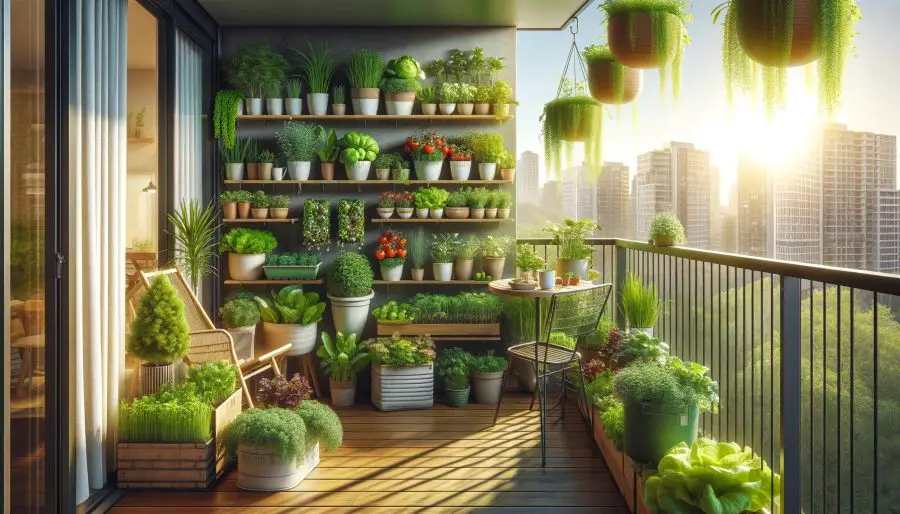
Dive into commonly asked questions about balcony vegetable gardening.
Find answers to how you can maximize your yield, the best containers for different plants, and effective ways to manage pests and diseases in a confined space.
Q. What vegetables can a beginner gardener grow?
A: Beginners should start with easy-to-grow vegetables like herbs leafy greens, lettuce, radishes, and beans. These require minimal special care and offer quick gratification.
Q. What should I put in my beginner vegetable garden?
A: Include a mix of salad greens, herbs like basil and parsley, cherry tomatoes, and easy root vegetables like carrots. These provide a variety of flavors and textures while being relatively straightforward to grow.
Q. What vegetables are easy to grow in pots?
A: Tomatoes, peppers, radishes, and herbs are particularly well-suited for pot cultivation. They adapt well to the constraints of container gardening and still yield a good harvest.
Q. How do I turn my balcony into a garden?
A: Start by assessing the space for sunlight and weight capacity. Use containers and vertical gardening techniques, choose suitable plants, and ensure adequate watering and care.
Q. What vegetables can you grow on a balcony?
A: Most small to medium-sized vegetables are suitable. This includes leafy greens, herbs, strawberries, cherry tomatoes, peppers, eggplants, and dwarf varieties of cucumbers and zucchinis.
Q. What is the best soil for a balcony garden?
A: A high-quality potting mix designed for container gardens is best. It should offer good drainage and enough organic matter to support plant growth. Coco coir is a good sustainable choice.
Q. What is the best container for a balcony vegetable garden?
A: Choose containers with drainage holes, made from lightweight materials like plastic or fabric pots. Size and depth should match the root needs of your chosen vegetables.
Q. What to put at the bottom of a raised garden bed on a balcony?
A: Use a layer of gravel or broken terracotta pots at the bottom to improve drainage. Then, add your potting soil on top.
Q. What is the best mulch for balcony pots?
A: Organic mulches like straw, wood chips, or bark are suitable. They help retain moisture and add organic matter to the soil as they decompose.
Q. Can you put a raised garden bed on a balcony?
A: Yes, but ensure your balcony can support the weight. Choose lightweight materials and consider a smaller, shallower raised bed designed for balconies.
Q. What is the difference between a balcony and a terrace?
A: A balcony is typically a small platform attached to a building, enclosed by walls or railings. A terrace is larger, may be open on multiple sides, and is often found on the roof of a building.
Q. How do I get the most out of my small balcony?
A: Utilize vertical space with wall planters and hanging pots. Choose multi-functional furniture and foldable items. Incorporate a variety of plants to create a diverse, multi-layered garden.
These answers provide valuable insights and practical tips for successfully setting up and maintaining a balcony vegetable garden, tailored to both beginners and more experienced gardeners.
Conclusion: Embracing Urban Balcony Gardening
As we draw our exploration of balcony vegetable gardening to a close, it’s clear that this charming endeavor offers more than just a splash of green in urban settings.
It’s a step towards a more sustainable way of living, a bridge to nature in the midst of the city, and a source of profound personal satisfaction.
Whether you’re harvesting your first homegrown tomato or savoring the tranquility of your leafy retreat, the rewards of balcony gardening are as bountiful as the crops it yields.
So, embrace this opportunity to nurture life on your balcony and enjoy the fruits of your labor in the heart of the urban expanse.
The Joy and Satisfaction of Gardening
-
- Experience the delight of tending to your plants and the satisfaction of harvesting your own produce.
- Enjoy the therapeutic benefits of gardening, fostering a sense of well-being and relaxation.
Sustainability and Environmental Impact
-
- Contribute to sustainability by growing food locally, reducing your carbon footprint.
- Engage in eco-friendly practices, like composting and organic gardening, to positively impact the environment.
Encouragement for Aspiring Gardeners
-
- Embrace the opportunity to transform even the smallest balcony into a green oasis.
- Whether you’re a beginner or experienced, balcony gardening is an accessible and rewarding endeavor.













